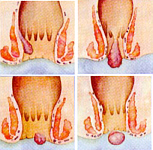A mass of dilated, tortuous veins in the anorectum, hemorroids come in two kinds: external,
which involves veins distal to the anorectal line; and internal, which involves those veins
proximal to the anorectal line. Prolapsed hemorroids are those internal dilated veins
protruding through the anus, while strangulated hemorroids are trapped by the anal sphincter,
cutting off blood flow to the vein in the hemorrhoid. They are usually caused by straining
to have a bowel movement or pushing in childbirth.
Helpful Links:
Hemorrhoids
en million people in the
United States alone have hemorrhoids. The peak age range to have an occurrence of
hemorrhoids is between 45 and 65. Typical symptoms are rectal pain, burning or
itching, and bright red blood on the toilet tissue or on the stool. Rounded swellings
or protrusions from the anal area may
also be present. Because all of these symptoms can be caused by other, more
serious conditions, those who suffer from hemorrhoids should be alert to the possibility
of inflammatory bowel diseases, ulcerative colitis, and Crohn's disease.
 Most studies
agree that low-fiber diets cause smaller caliber stools, which can result in excessive
straining during
a bowel movement. Foods rich in fiber, proanthocyanidin and anthocyanidin can help prevent
future hemorrhoids and help current ones heal.
Ginkgo is an herb
that helps strengthen blood vessels. It is anti-inflammatory, as well, which helps
alleviate the pain and itching associated with hemorrhoids.
Dandelion and
Yellow Dock are both
known to be gentle, mild laxatives. The roots of these two herbs help soften the stool
and thus relieve constipation.
Most studies
agree that low-fiber diets cause smaller caliber stools, which can result in excessive
straining during
a bowel movement. Foods rich in fiber, proanthocyanidin and anthocyanidin can help prevent
future hemorrhoids and help current ones heal.
Ginkgo is an herb
that helps strengthen blood vessels. It is anti-inflammatory, as well, which helps
alleviate the pain and itching associated with hemorrhoids.
Dandelion and
Yellow Dock are both
known to be gentle, mild laxatives. The roots of these two herbs help soften the stool
and thus relieve constipation.
 These
products are available from our
Virtual Store.
Our liberal
Money Back Guarantee applies.
These
products are available from our
Virtual Store.
Our liberal
Money Back Guarantee applies.